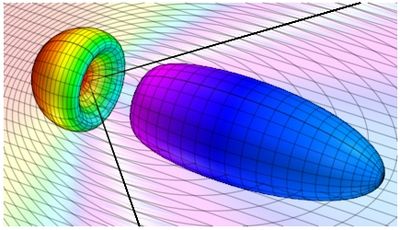 |
Tachyons, Time Travel, and Paradoxes
Tachyons are faster than light particles. Are such things possible and if so,
are there odd effects which may arise because of them? Here, we consider
experiments, paradoxes, and possible ways out.
|
Acausal Signals
For the signal which travels from P to Q, there may
be issues for a moving observer, even if the observers moves with v < c.
The black line marks the curve vt = ct' and the magenta line marks the line
of simultaneity (the x'-axis). Note that the signal is sent at time ct = ct'
= 0, but is received at time ct' <0 ===> it is received before it is sent.
This leads to issues. This effect leads to the Anti-Telephone,
and to the Tolman Paradoxes (causality issues).
Anti-telephone messages are theoretically possible, but people cannot travel
backward in time.
|

|
 |
Tachyons
In Special Relativity, because we require that the laws of physics are of
the same form and that the speed of light is the same for all observers in
inertial frames, the energy and momentum of particles must have different
forms than which you are familiar. To the left is shown the energy of a particlein free space in Special Relativity. You are more familar with the form
E = 0.5 mv2 + mc2
Actually we don't usually add the rest mass energy because in classical
physics we can't tap this energy and so we just usually redefine the energy
as E' = E + mc2. For v > c, the radical leads to an imaginary
number. In order for the energy to be real, this means that the rest mass of
a tachyon must be imaginary!
|
 |
Cosmic Ray Showers
Primary cosmic rays produce
extensive air showers when they strike nuclei in our
upper atmosphere. In such interactions produce tachyons, we expect that they
would arrive at the ground before the shower particles. After an early
possible detection by Ashton et al. (1977), no subsequent work has
produced a positive result.
|
Cerenkov Radiation
In a medium, such as water where the index of refraction is n > 1,
a beam of light travels with speed v = c/n < c. In this medium, if
a charged particle can travel faster than c/n, it will emit
Cerenkov radiation (much as a supersonic jet produces a sonic boom). In the
panel to left, the faint blue glow in the reactor is Cerenkov radiation.
The Japanese Super-K neutrino detector on the Cerenkov effect to detect
neutrinos. High energy neutrinos scatter and produce high energy muons and
electrons which travel faster than c/n leading to Cerenkov radiation
(see panel to the right). If
charged tachyons exist, then they would produce Cerenkov radiation in
vacuum, losing energy and speeding up!
 |
Neutrinos
Neutrinos are ghost-like sub-nuclear particles. Until the last decade,
neutrinos were generally assumed to be massless and to thus travel at the
speed of light. However, with the resolution of the Solar Neutrino Problem
wherein neutrinos may change form as they travel through the Sun, it is clear
that neutrinos are not massless and so do not have to
travel at the speed of light.
Tritium beta-decay experiments are
consistent with m2 < 0 or that m is
imaginary. The MINOS experiment (from Fermi-lab to the Candian border) measures
the differences between the squares of the muon and tau neutrino masses. They
do not claim that m2 is negative, they measure the difference
between m2; and their results are consistent with v < c,
but v > c could sneak in under the error.
|







